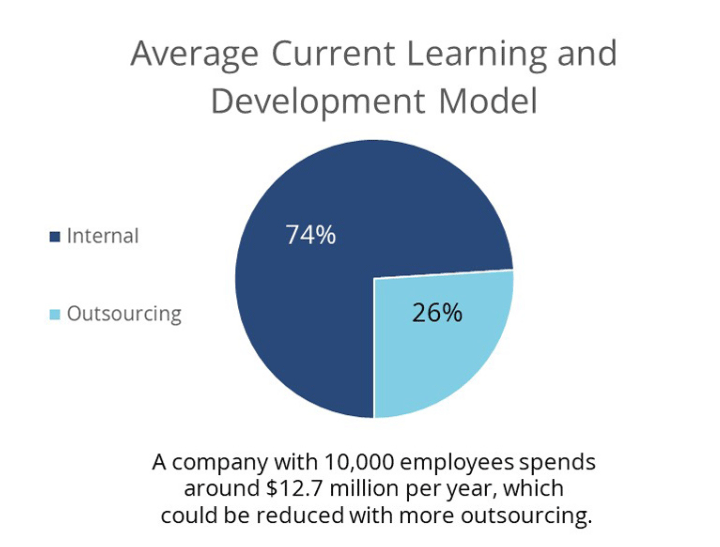As many companies look to shrink and stabilize their budgets, they may overlook an easy way to save money and still maintain effectiveness in the critical area of training. It’s imperative to have a good training staff at your organization, but you also want to make sure you don’t have more full-time positions than required as training needs ebb and flow. A relatively new way to handle this involves managed services that support training design, development and deployment.
Managed services for training gives an enterprise the opportunity to supplement its core training and learning experts when it has a big project, onboarding effort, new software implementation or other training requirement on the horizon.
Managed services monitor the client organization’s training needs and then address them with a package of training standards and materials, training-software licenses, train-the-trainer programs, training logistics support and more. This includes administration of the training delivery with a learning management system, coordination of classes and preparation for the trainers. All the while, the company gets to maintain a steady payroll and staff in the training area, no matter how much or little training work is demanded at any given time. The supplementary staff also helps reduce long lead times for creation or updates of training materials that can result from having too few in-house resources.
Here are 10 good reasons to use training managed services to help you scale resources, boost speed to market and more:
- Leveraging the cost of technology – One of the first expenditures training professionals make when starting up a training organization is to license a training-material creation tool for the enterprise because it’s cheaper than designing and building training materials from scratch, using more manual techniques. A managed-services provider can handle this purchase for you as part of a package.
- Realizing training is not core to your business – For many companies, training is a necessity, but the development, management and delivery of training can be a distraction from their core business. That’s why companies outsource to providers that consider training central to their business.
- Generating revenue – More and more companies now recognize training is a source of revenue and that they have intellectual property valued in the market. This is why they use a provider that knows how to market, sell and deliver training to a mass or targeted audience to create new revenue streams. Ask Microsoft, Cisco, and Red Hat (just to name a few) that already do this.
- Mitigating risk – Training helps prevent failures and protect from liabilities. If we don’t provide the training our employees or clients need when they need it, then we’re vulnerable to being sued if an injury or catastrophic failure occurs. Also, if a company fails to train its personnel on upgraded software, it risks losing the benefits the upgrade was designed to provide. Providers that specialize in training help reduce risk and prevent unnecessary costs because they are experts in this field.
- Improving scalability of resources – Running an internal training organization requires people of various skills and talents. Full-time internal staff is a fixed resource, but training is a variable activity. Using an external provider allows you to flex the number of resources to deliver the training you need, when you need it, and allows your company to scale easily up and down.
- Leveraging channel relationships – A software company, for example, may choose to source the marketing and delivery of its training to an established IT training company. Managed-service providers have existing relationships with these specialty training companies that have powerful ties to IT professionals.
- Boosting speed to market – Bringing a new product to market may be dependent on getting resellers trained on how to sell or service your product. Using a training outsourcing company means your product is in the clients’ hands much faster, without scaling up internal resources.
- Increasing geographic reach – Using a managed-service provider can improve your ability to deliver translated and localized training materials in a consistent way regardless of location.
- Improving access to talent – No company has all the knowledge it needs internally to be successful. Sometimes, you need a specialized set of skills. A managed-services expert can bring in the right consultants to deliver – or teach employees how to deliver – a new training course, when niche experience is required.
- Reducing costs – The main reason companies outsource training is to save money. It’s the common denominator for all the other reasons above. How you manage training is always about how to manage costs.
According to the Association for Talent Development, organizations spend about $1,273 for direct learning per employee per year. Almost 75 percent of that is for internal learning and development, and only around 25 percent is outsourced. This means a company with 10,000 employees spends around $12.7 million annually to support learning and development, and a whopping $9.5 million of that goes toward internal functions.

Managed services in the area of training can help you reduce costs, streamline your business processes to improve service levels, provide a strategic plan to maximize learning and meet goals, better administer learning and more. Providers leverage best-in-class tools and resources to deliver cost-effective, digitally enabled training and continuous learning.
Organizational change management (OCM) activities, including training, help make sure employees are ready and comfortable with changes at any company, so they quickly adapt, and the company realizes benefits faster. According to the Center for Management and Organization Effectiveness, managing and dealing with change is the No. 1 challenge for learning and development professionals.
ISG offers training managed services as part of its OCM lineup. ISG focuses on avoiding generic offerings and instead supplementing with a specific skill set and training that match the needs of the IT and the customers (managers and end users). Contact us for more information.
Please fill out this form to continue.
